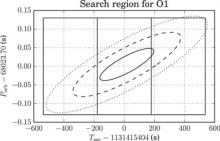
Abstract
We present the results of a semicoherent search for continuous gravitational waves from the low-mass X-ray binary Scorpius X-1, using data from the first Advanced LIGO observing run. The search method uses details of the modelled, parametrized continuous signal to combine coherently data separated by less than a specified coherence time, which can be adjusted to trade off sensitivity against computational cost. A search was conducted over the frequency range from 25 Hz to 2000 Hz, spanning the current observationally-constrained range of the binary orbital parameters. No significant detection candidates were found, and frequency-dependent upper limits were set using a combination of sensitivity estimates and simulated signal injections. The most stringent upper limit was set at 175 Hz, with comparable limits set across the most sensitive frequency range from 100 Hz to 200 Hz. At this frequency, the 95 pct upper limit on signal amplitude h0 is 2.3e-25 marginalized over the unknown inclination angle of the neutron star's spin, and 8.03e-26 assuming the best orientation (which results in circularly polarized gravitational waves). These limits are a factor of 3-4 stronger than those set by other analyses of the same data, and a factor of about 7 stronger than the best upper limits set using initial LIGO data. In the vicinity of 100 Hz, the limits are a factor of between 1.2 and 3.5 above the predictions of the torque balance model, depending on inclination angle, if the most likely inclination angle of 44 degrees is assumed, they are within a factor of 1.7.